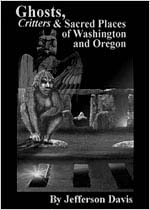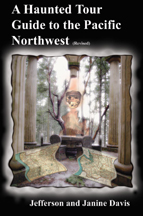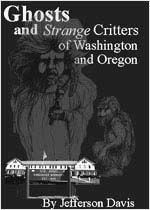|
__________
|
Although my books are meant to describe the ghostly heritage of the Pacific Northwest, they would not be complete without a discussion of the supernatural and non-supernatural creatures of the region. I use the word critter as a catch-all for these animals, rather than the word monsters. Monsters are unnatural creatures that threaten people. Some of these animals are natural or supernatural, and very few of them threaten anyone. Many of the stories of this area have been handed down from older, Native American traditions. The Indians had several stories of critters living in the high mountains. There was a race of giants who lived in villages in the mountains. They were very quiet, but would sometimes fight. When this happened, they would cause avalanches of rocks or snows in the mountains. Sometimes the giants would come down to houses and stand, looking down the smoke holes, watching people. Despite their size and strength they were not always hostile to humans. There was a race of giants with long hair called the St-plah . They lived a solitary existence, at the bottom of large ponds and lakes. When they saw someone standing at the edge of their lake, they would rise up and seize them, taking them down to the bottom. In some cases the giants would eat them, in other cases they would kidnap them to make them slaves. There were also friendly beings that lived in the water that befriended people, sent them visions or married them, producing a race of hybrids. On the Trail of Bigfoot Not withstanding a recent spate of articles in tabloid newspapers about Bigfoot coming from outer space to mate with humans, stories of the bigfoot go back hundreds, possibly thousand of years. There have been recent archaeological discoveries regarding the age of human occupation of North America, pushing it back perhaps over 40,000 years. In the Aleutian Islands, 2,000-year-old mammoth bones were also discovered. These give more credence to the thought (by some), that some animals lived on, long after scientists thought they might have become extinct. There are some that believe that Bigfoot was the first hominid (great ape), inhabitant of the Pacific Northwest and man was second. There was a species of hominid or great ape called Gigantopithecus. Based upon fossil evidence, the Gigantopithecus was a vegetarian creature that easily stood over six feet high. Like many of the other man-like creatures, they died out over time. Fossil remnants of Gigantopithecus dating to one million years ago have been found in ancient China. Some people looking for a natural explanation for Bigfoot have speculated that the Gigantopithecus spread out from Africa to Asia and continued over to North America several million years ago. When the Asian Gigantopithecus died out, their North American relatives survived. The Native Americans of the Pacific Northwest had many names for the hairy people of the woods. J.W. Burns may have used the common modern name of Sasquatch first in the 1920s. Sasquatch was probably derived from the name used by coastal Salish natives of the lower Frasier river: se'qec. It was not the only name used. There are many more names from Native Americans from the Dalles north to Alaska and south into California. Almost all legends describe them as gigantic and smelling badly. The stories also agree that they lived in the mountains or deep in the woods. Their feet are shaped like a bear, but were over 18 inches long. This is the most popular description, but not the only one. Some tribes tell stories about the Sasquatch not having fur. Their habitat was confined to the mountains in winter, where they lived in holes in the ground. They would come down from the mountains during fishing season. They would fish by the river, avoiding people for the most part. In the 1830s Sasquatch carried off a Hudson's Bay Company employee's Indian wife. According to the story, she was kidnapped from the vicinity of Fort Vancouver, and carried into the woods a few miles away, before she escaped. As in modern times, many Native American's told tales of hunting Sasquatch. Although many were shot and tracked by the trail of blood, no hides or bodies were ever produced as evidence of the hunt.
David Thompson and the snow monster? (British Columbia) Out of this folklore and oral tradition, there are historic accounts of Bigfoot sightings recorded in the early 1800s. In 1811 David Thompson saw footprints that later readers have interpreted to be those of a Sasquatch. He was traveling through the outlands of British Columbia in the winter when he came on a set of footprints in the snow. The track was 14 inches long and 8 inches wide. He noted that the footprint had only four toes and that each toe had a claw four inches long. He also noticed that the ball of the foot was indented deep into the snow, while the heel was not well marked. This could have been the result of whatever creature it was had been standing on the forward part of it's foot.
A Spirit Snake? Turnbull National Wildlife Refuge (Washington State) In the 1980s the Healy family was vacationing in the Turnbull Wildlife Refuge and caught a small snake they named Slinky. The snake seemed harmless and the family's two children wanted to take the snake home with them. Instead, the father posed for a picture, holding the snake. They released the snake who slithered away. When the family returned from their trip they turned in the film to have it developed. When they got the prints back from the photo lab there was a picture of Mr. Healy, with his hands spread, holding thin air. The picture was perfectly developed, with no flaw on it or the film. Where did the snake go? Can dead snakes become ghosts or did they pick up something else?
A Rain of Salamanders (Boring, OR) In June of 1911 a young girl was walking along the banks of the Sandy River when it began to rain. This is not an unusual occurrence in the Columbia River gorge. What was unusual was the things mixed with the rain. In addition to raindrops, the girl was pelted with several heavy objects. She looked around and watched hundreds of salamanders fall from the sky and cover the ground around her. Most of the salamanders were alive, and began to scurry around, seeking some kind of shelter. What caused the rain of amphibians? There have been many incidents where there have been rains of various substances such as fish, frogs, stones, alligators, grain, nuts, leaves, straw, stones, money and even blood and raw meat. These incidents have been recorded all over the world for over two thousand years. There have been several theories to explain these incidents. Charles Forte made a career of recording and reporting strange incidents, such as these mysterious rains. He suggested (facetiously) that there were floating continents in the sky. When there was a storm on the floating continent, it dumped garbage on the solid earth below. There are of course more serious theories. One theory is that violent storms on land and sea can and will pick up solid matter as well as water. If a storm forms a funnel like a tornado on land or a water spout at sea, that they will carry this matter for a period of several hours. In that time the storm could travel several hundred miles before dropping the matter as it dissipates. In that time, the storm, particularly a circular storm like a tornado would operate like a centrifuge as it spun around in a circle. This action would separate objects of different specific gravity and gather together objects of similar density. For example, if a tornado stormed over a pond it may have gathered thousands of gallons of water, and everything within the water. As the storm spun round, the algae or plants would have been gathered together, the frogs would have been gathered together, etc. Were the salamanders picked up by a storm and transported hundreds of miles through the air to land in a strange place? The unfortunate thing about these kind of sightings, is that the victims cannot tell where they came from.
Copyright © 1996-2001 by Jeff Davis | Maintained by J. Goodman |





